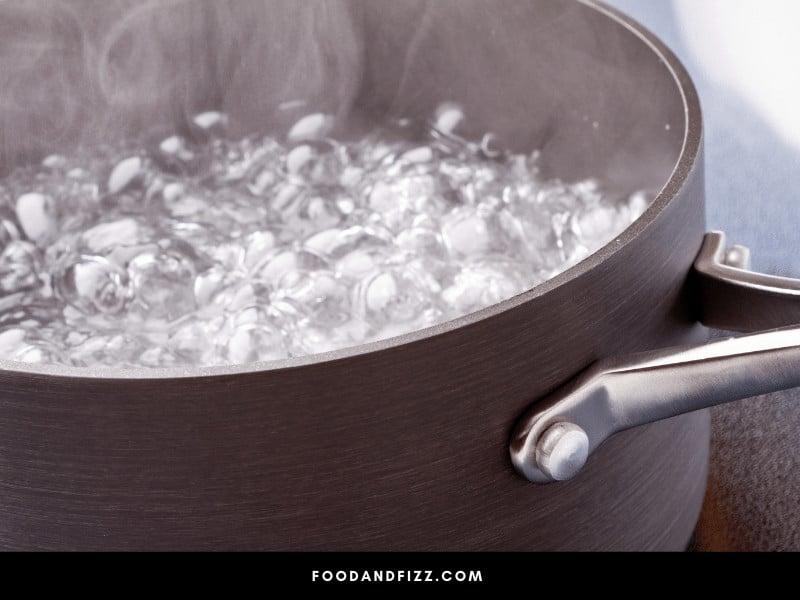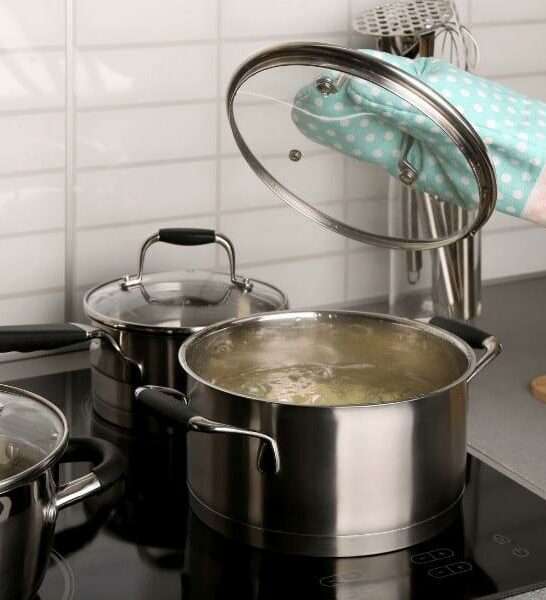Does Water Boil Faster With a Lid? I imagine thousands, maybe even millions of cooks have stopped to wonder if covered pots really do cook faster.
I’ve watched my wife cook and often notice her instinctively covering the pot when cooking up one of her mouth-watering delicacies, but I have no idea why she uses a lid or what effect she expects it to have on her cooking.
Now that I think about it, I will have to ask her the next time we’re in the kitchen together.
In the meanwhile, I will own up to knowingly using the lids on my pots and saucepans to speed up my cooking or even to more thoroughly cook a food item. I understand the fundamental physics of cooking, so I’m lucky that I can leverage that information for my culinary purposes.
By the end of this article, you, too, will understand the science behind covering boiling liquids with the pots and pans covered up.
Does Water Boil Faster with A Lid?
Water boils faster with the lid. Experiments show that water boiled with the lid off takes about six and a half minutes to reach boiling point. On the other hand, water boiled with the lid takes only around five and a half minutes. This equates to a reduction in boiling time of roughly 25%.

Boiling Water with The Lid Off – Natural Evaporation
Coming to a simmer
When you apply heat to the bottom of a pot, the liquid nearest the heat source gets hot first (duh). The thing is, hot water is lighter than cold water. So, being lighter, the hot water at the bottom of the pot rises to the top.

The (relatively) cold water at the top of the pot has to go somewhere. At the beginning of the cycle, this ‘somewhere’ is down, wherefore the cold water sinks to the bottom of the pot.
On its way down to the bottom of the pot, the sinking cold water perforce interacts with the rising hot water.
This leads to a bit of give-and-take, in which the rising hot water imparts some of its heat to the sinking cold water, and likewise, the sinking cold water imparts some of its coolness to the rising hot water. (Actually, ‘coolness’ isn’t a thing in itself. It is a lack of heat, just like darkness is a lack of light.)
At the beginning of the boiling cycle, the sinking cold water might not get all the way to the bottom of the pot, nor will the rising hot water necessarily get all the way to the top.
An observant observer looking at what’s going on through a clear pan or pot will see a movement like a cyclical swirling motion, like an invisible inner fountain at the bottom of the container continuously spewing liquid up to the top of the vessel. Just to be clear, these are convection currents, not Brownian motion.
Coming to a boil
As you apply more heat to the pot, the sinking cold water gets warmer and sinks further down more quickly. Eventually, the water that is sinking is only fractionally colder than the hot rising water, so much so that it hardly has time to reach the bottom before it too is racing back up to the top of the pot again.
In my moments of fancy, I like to think of the water molecules yelling, “Ouch, ouch! Lemme back up out of here!”
Imagining water molecules yelping in alarm while trying to get away from the heat source is certainly fanciful, but if we allow the imagery, we can let ourselves imagine that a time comes when molecules begin to earnestly fight to stay away from the bottom of the pot.
This vigorous, boisterous, roiling activity is commonly called ‘boiling’ and occurs at boiling point. At this stage, water molecules chuck in the towel and abandon the container altogether, escaping into the blissful cool of the air, an activity we call ‘evaporation.’
Air pressure matters when it comes to boiling point. At standard pressure, which we get at sea level in one atmosphere, water boils at 212°F. At lesser pressures, say at the top of a mountain, water boils at much lower temperatures. At higher temperatures, say at the bottom of the Mariana Trench, water would boil at a very high temperature, far higher than 212°F.
When water–or any liquid–boils, several of its molecules have passed into their gaseous state. They form little bands, then bigger groups, then armies of giant bubbles, and force their way to the top and out into the atmosphere. It is this action that you see when you look at a container of water bubbling away when it is boiling.

Boiling Water with The Lid On – Constrained Evaporation
Now that you have some idea of what happens in unconstrained boiling, let’s compare that process to what happens when water is trapped in a pot with its lid on.
Simmering and boiling with the lid on
Without the lid on, even as water comes to a simmer and eventually begins to boil, vapor that has managed to escape from the water is free to escape into the atmosphere, where it has no further influence or effect on the boiling water. The same is not true when the container is covered by a lid.
In the case of a lid-covered pot, vapor from simmering water is not really free to escape into the air in the kitchen to find a nice safe space in which to calmly cool down. Instead, it is forced to hang around in the vicinity of the cauldron from which it has just departed. In doing so, it inadvertently has two important effects on the heated water.
Recycled heat. The first effect is that the vapor remains in contact with the surface of the simmering or boiling water. In this way, there is heat transference back into the body of water that is absent when the pot is uncovered. The impact of this reused heat is that the simmering phase is markedly lower, and yes, the pot comes more quickly to a boil.
Increased pressure. The second effect is that all the water vapor trapped under the lid builds up local atmospheric pressure above the boiling water, and as explained earlier, this raises the temperature at which water boils. Now in this instance, the water is already boiling, so what actually happens is that the water temperature increases past the 212°F standard boiling point. The boiling water gets even hotter.

Experiment–Which Brings Water to a Boil faster, Covered or Uncovered Lid?
An experiment ran at the 2010 California State Science Fair demonstrates a popular methodology to objectively test whether there is a measurable difference between the length of time it takes to boil water with and without the lid of the containing vessel. Results consistently indicate that heating the container with the lid on leads to an incredible 25% reduction in the time spent boiling the water.

Afterword: Does water boil faster with a lid?
When covered, pots, pans, and sundry other containers get two effects from vapor trapped under the lid, recycled heat, and increased pressure. Consequently, water in the container comes to a boil more quickly than otherwise and boils hotter. Cooks can use these facts to boil water faster and cook food items hotter, a sometimes valuable trick with meats, poultry, and seafood.
Frequently Asked Questions On Does Water Boil Faster With A Lid?
Does water boil faster with the lid on or off?
Water boils faster with the lid on because it contains heat better and allows the water molecules to reach the boiling point of 212°F faster compared to when there is no lid on the pot. Boiling water with no lid on also leads to some natural evaporation.
How fast does water boil with the lid on compared to when the lid is off?
According to some experiments done, the time it takes to boil water was reduced to about 25% if it is boiled with the lid on. It takes a shorter amount of time to boil water with the lid on vs. with the lid off.

